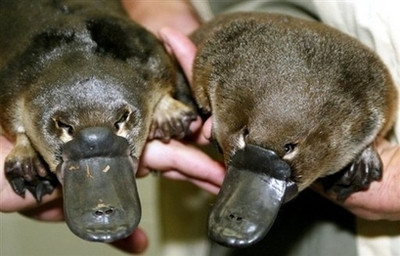World's strangest creature? Part mammal, part reptile
(Agencies)
Updated: 2008-05-08 16:41
Updated: 2008-05-08 16:41
The platypus sports fur like a mammal, paddles its duck feet like a bird and lays eggs in the manner of a reptile.
 The world's first platypus twin puggles born in captivity are shown at Taronga Zoo in Sydney in 2003. The task of laying bare the platypus genome of 2.2 billion base pairs spread across 18,500 genes has taken several years, but will do far more than satisfy the curiosity of just biologists, say the researchers. [Agencies]
|
Nature's instruction manual for this oddball, it turns out, is just as much of a mishmash.
Researchers just mapped the genome of a female platypus from Australia. The genetic sequence of this Aussie monotreme (a type of mammal) is detailed in the May 8 issue of the journal Nature.
"The platypus is a very ancient offshoot of the mammal tree, so it was 166 million years ago that we last shared a common ancestor with platypuses," said study team member Jenny Graves, head of the Comparative Genomics Group at the Australian National University. "And that puts them somewhere between mammals and reptiles, because they still maintain quite a lot of reptilian characteristics that we've lost, for instance they still lay eggs."
She added, "So we can use them to trace the changes that have occurred as we went from being a reptile, to having fur to making milk to having live-born young."
The primitive mammal lives in burrows in Eastern Australia dug along the banks of streams and rivers that it relies on for food. Its flat, streamlined body extends just 20 inches (50 centimeters), tipped with a tail that resembles a ping-pong paddle and four webbed feet. The platypus (Ornithorhynchus anatinus) is one of only two mammals - the other is the echidna (spiny anteater) - that lays eggs. And unlike other mammals, the male platypus can deliver venom from a tiny spur on each hind limb.
To sort out the evolutionary relationships among platypuses and other animals, the team compared the genome of a female platypus nicknamed Glennie with those of humans, mice, dogs, opossums and chickens. (Chickens were included to represent egg-laying animals, such as extinct reptiles, that passed on much of their DNA to the platypus and other mammals in the course of evolution.)
|
||
|
||
|
|
|
|

